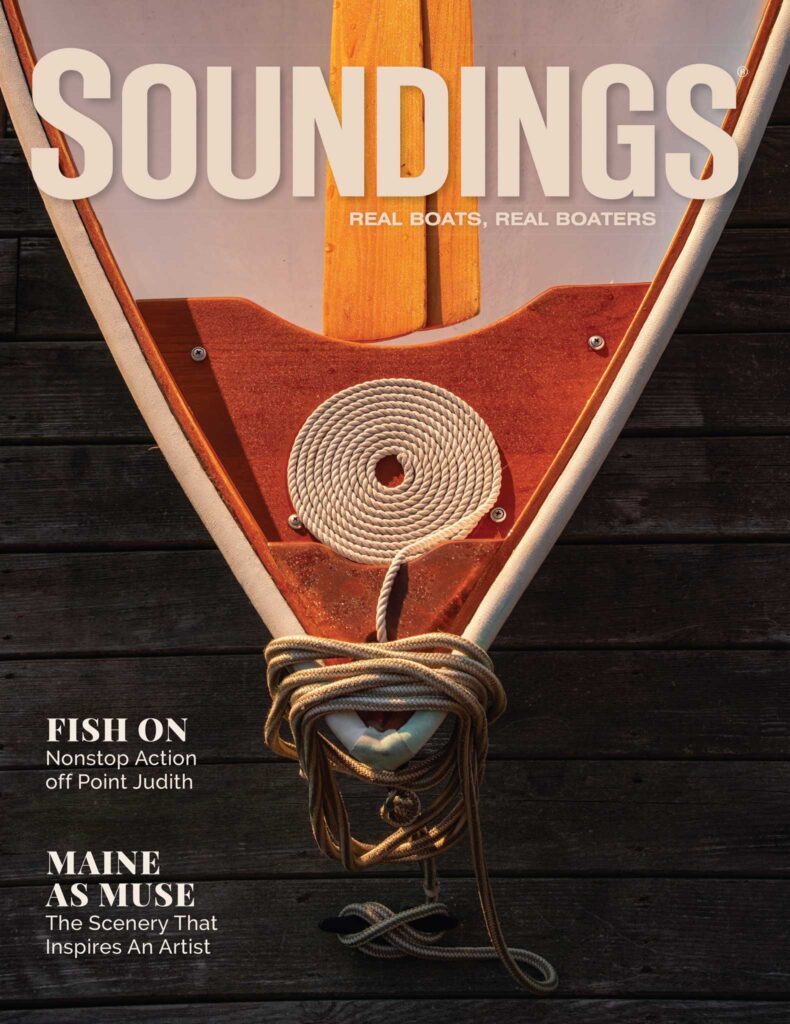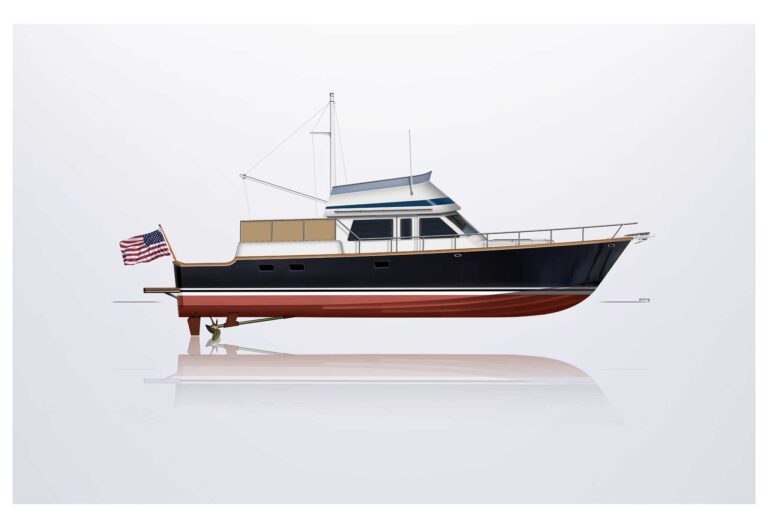The evening began like a fishing daydream. The sun was dropping. The flooding tide and a cool wind were roughly aligned. Four of my five children were aboard our 26-foot center console, which was rising and falling at anchor just beyond the surf line and a row of cottages on the Rhode Island shore. The older boys were slinging ladles of clam-belly chum over the gunwales, creating a plume that drifted toward a pile of boulders perhaps 100 feet away.

The kids’ plan, conceived over dinner a short while before, had been as straightforward as it was promising. They hoped a sweet-smelling slick might draw a few foraging stripers to baited hooks resting on the bottom, offering a chance to wrestle fine bass on light tackle and be home at a reasonable hour for bed. I admired their clear thinking. There had been striped bass in recent nights around these stones, and this would be an easier manner of catching a few of them than trying to cast eels on repeated drifts. The only problem we could anticipate — the kids might have to work through a swarm of black sea bass and scup while waiting for stripers to show — was not really a problem at all.
Then events took a serendipitous turn.
At nightfall, as lamps in the nearby cottages were starting to light, one of the lines began moving across the tide. The movement was slow. Something had picked up a clam with its hidden barb, but without a bass’s confident strike or a scup’s pesky tap.
The kids, being kids, were chatting. They did not notice. I lifted the rod, took up the slack, felt weight and drove in the hook. The light rod responded oddly; it bent steeply but did little more. The fish felt as if it were content to glide.
I handed the rod to Elizabeth, who was 10.
Our mystery fish continued its unusual antics while Elizabeth cranked on the reel. Twice it made abrupt changes in direction, as if it were flipping over. When it neared the starboard side, one of the boys switched on a headlamp for a glimpse, and into the dim cone of light appeared the small dark eyes and undulating fin of a large American eel. The fish looked to be about 3 feet long and was almost exactly the color of our compost pit when it has been covered with an especially heavy load of poultry crap.
We swung it aboard. As the eel thumped onto the deck and began to swim across the wet surface like a snake, there were no cries of disgust or groans of disappointment. The young crew erupted in knowing joy.
“Remember the eel we caught a few summers ago?” asked Mick.
He was 12, and he looked out toward the deeper water where that other eel had similarly surprised us and summoned, with a mere turn of his head, the tangible body of memory and knowledge that people who fish together long enough share. An entire and finely textured universe seemed to orbit above us.
“It was so delicious,” he added, which it was.
And there we had it.
As this latest eel worked its mouth slowly and twisted itself into a near knot, displaying a classically ugly form, the kids were emanating contentment. Never mind that this was not the striped bass they had come for. They were not measuring the eel against what it might have been. They valued it according to an ancient, practical and superior standard, one that helped carry humankind across time: They valued it by how they expected it would taste.

No apologies
Let it be said loudly and without flinching: We fish for meat.
In an age when many anglers speak forcefully about conservation or pursue exotic species and specialized techniques, such a declaration risks sounding sacrilegiously tone-deaf. But this is no crude statement, no lead-dunker’s manifesto, no strain of stubborn redneckery. The fact that our boat is well-stocked with hi-lo rigs, bank sinkers and chum ladles does not mean that we do not take fishing seriously or release many fish, or that we do not enjoy the intangibles that come with fishing in many forms. It means something else entirely: the idea that fishing can be a central activity of living in closer concert with the environment and that anglers who engage in the full, primal experience — finding, catching, cleaning, storing and eating the quarry — are purposefully choosing more natural lives than our busy culture encourages or makes easy to realize.
This is serious stuff, even if it often lacks an advocate. We study our local fish species and their habits closely, we follow the assessments of stocks with curiosity, and we believe with ferocity that fisheries in decline must be nurtured back to health and that stocks that are abundant should be fished in ways that do not cause them to crash. (It is one of the great shames of the modern fishing era that the word “crash” occupies so familiar a place in our coastal lexicon.) Yet still we apply ourselves to catching and eating a considered share.
We also express perplexity at some of the fishing happening around us, which is repeatedly celebrated in heaps of fishing magazines. A large fraction of what gets presented as fishing in our time feels as if it has drifted far from fishing’s origins. The basic human urges that energize people to pursue fish — to enter an ecosystem and know it, and thereby find and catch meat — have here and there been supplanted with activities that resemble fetish. Only the more useless strands of human DNA can be behind the desire to catch ever larger specimens of a particular fish species on a tippet the strength of a hair, and then to compare such feats with others who care. And fishing is not performed more ably by those who wear jumpsuits bearing tackle-company patches or shirts with their names stenciled atop a pocket than it is by you or me. It is hard to understand much of what has passed for fishing in my lifetime; I stopped trying decades ago.
Fishing, experienced fully, is instead this: a series of sea-to-table cycles that change throughout a year but repeat throughout a life. And so as local ocean waters change with the movement of seasons, subtly at times and sharply at others, we eat from the rips the same way and with the same forethought with which we eat from our gardens. Each variety of migrating fish has its times. And with cookbooks and recipes as integral as tide charts and hooks, and skill with a knife almost as highly valued as abilities with a rod, our boat and shed of tackle become tools in a harvesting system that allows us to seek, kill and sample what comes near. (Anyone who thinks this unnatural or callous should ask himself from where his food comes.)
But we do not consider this bounty to be solely ours. After days or nights of plenty we make a habit of hauling more than we can eat fresh or eat alone. This catch we ice and bring ashore to share with neighbors and friends, or put up for out-of-season meals. The scraps and the fish frames, in turn, are worked into the soil to enrich the dirt that we use to raise crops.
Our local fish — experienced as they experience each other, as food — yield a richness we would not choose to live without.
A time for knives

Back to the night’s work just outside the surf.
The hook was rebaited. The line returned to the water. More clam-belly chum was slung over the side.
Talk turned, as we waited, to the last big eel we had seen, which Mick had caught a few years before in confused tides in about 50 feet of water in front of Point Judith.
We had been riding chop and dunking bait that day for black sea bass, and the eel had completed a cooler heavy with sea bass and scup. It had also left a fine bite on my right thumb when I had mistaken it for dead and tried to remove a hook from its mouth; the bloody thumb earned me amused chuckles from my father, who had been aboard that day, three generations of us hauling meat.
Later that same afternoon, while I filleted the other fish, Mick draped the skinned eel on a cleaning table beside the tomato patch, then cut its bright-white carcass into small steaks, each about 3 inches across and an inch thick. These the boys marinated and grilled, producing a midsummer night’s dinner — fresh eel and fresh corn, the bones and the cobs to be tossed into bushes — that none of us will soon forget.
Now the boat rocked gently at anchor just beyond the surf line, and we sat easily in the darkness. One of the rods twitched. A short while later yet another eel was twisting on the deck, this one larger still.
So much for that thing called sport fishing, which we are often sold as something that it is not. We were passing a night of striped bass fishing with no sign of a striped bass. I’ve not often seen the kids happier. They were glowing, having boated yet another meal they were bound to remember, and by their own hands.
It was time, as it often is when life is working as we hope it will, to head for the dock, and the knives.
A longer version of this article appeared in the Spring 2015 issue of Soundings’ sister magazine Anglers Journal.










